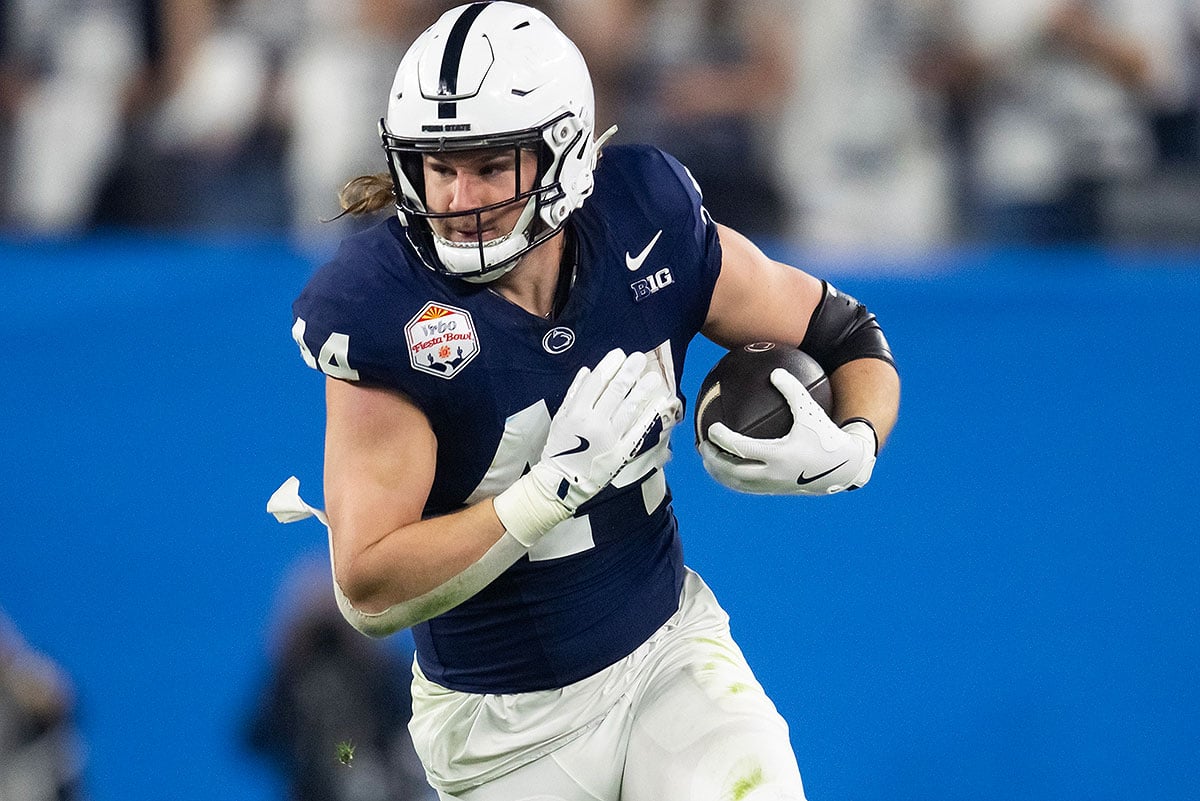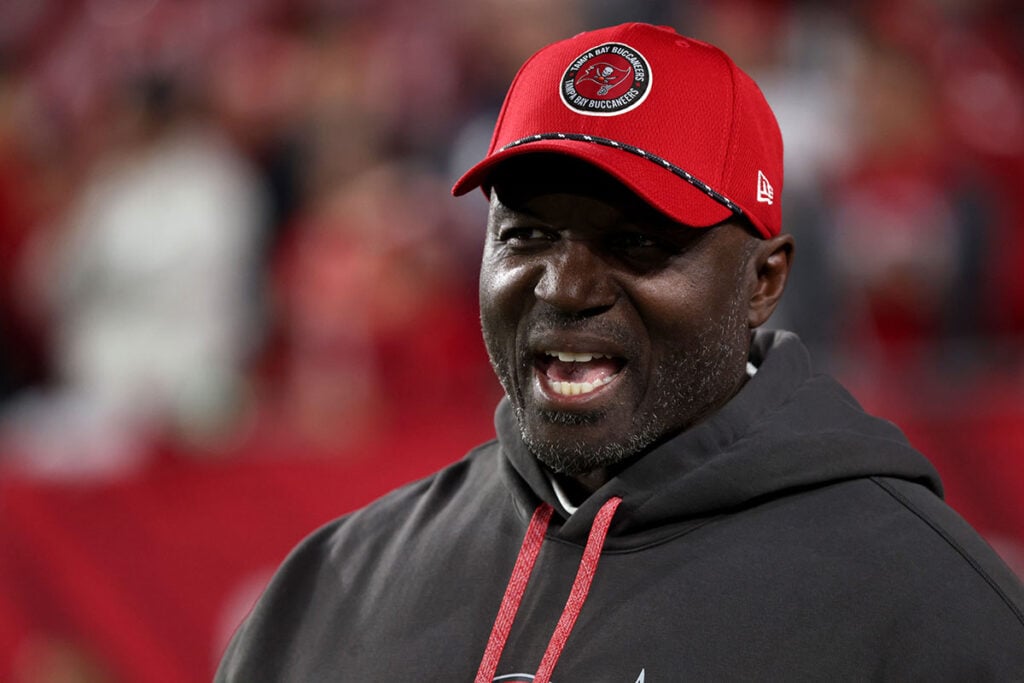Pewter Report analyzes the top players in the 2025 NFL Draft with its position previews. Scott Reynolds continues the previews at the tight end position, offering a comprehensive look at what the Bucs have and what they need at tight end.
Adam Slivon then analyzes a detailed list of this year’s top tight end prospects while Reynolds provides the annual Pewter Report Bucs Best Bets – the most likely tight ends for Tampa Bay to select in Rounds 1-3, and in Rounds 4-7.
What The Bucs Have At Tight End
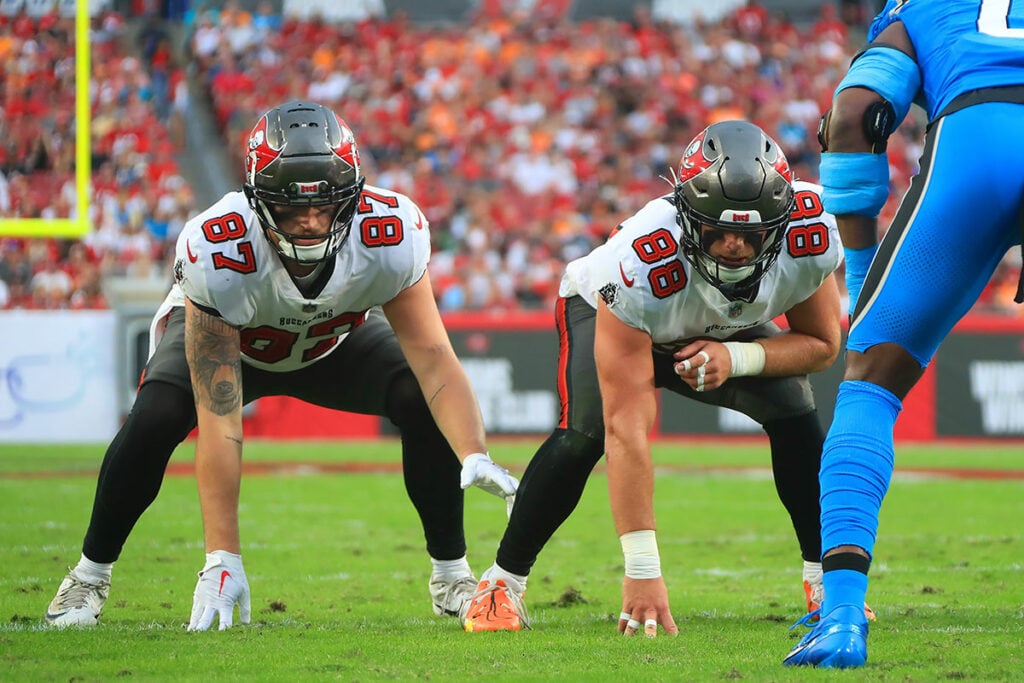
Bucs TEs Payne Durham and Cade Otton – Photo by: Cliff Welch/PR
The Bucs have a very young and underrated tight end room thanks to recent drafts. Tampa Bay has invested three Day 3 picks on Cade Otton (fourth round, 2022), Payne Durham (fifth round, 2023) and Devin Culp (seventh round, 2024) over the past four years and has been a nice collection of up-and-coming talent. Is there a Pro Bowl-caliber star among in the group? Not really.
Otton is more Cam Brate than he is Rob Gronkowski. He’s a reliable receiver and an improving blocker in the run game who is in line for a contract extension this offseason. Otton finished as the Bucs’ second-leading receiver in 2024 with a career-high 59 catches for 600 yards (10.2 avg.) and four touchdowns.
Durham really improved over the second half of the 2024 season as both a blocker and a receiver. He also posted career highs with 11 catches for 115 yards (10.5 avg.) and his first two touchdowns while proving to be an effective short-term injury replacement for Otton at the end of the year. That late-season surge likely prevents the team from needing to draft another tight end this year.
Culp also came on at the end of the season as he was finally active on game days due to Otton’s knee injury. The Bucs drafted him due to his 4.47 speed, as he was the fastest tight end at the NFL Scouting Combine last year. Culp caught five passes for 88 yards in his rookie season and his 17.6-yard average showcased his speed.
Tampa Bay also has Ko Kieft and Tanner Taula on the roster. Kieft is nothing more than a special teamer and a reserve blocking tight end and is entering a contract year. Taula has been on the practice squad the last two seasons, but has struggled with injuries.
What The Bucs Need At Tight End
The Bucs don’t really have a need at tight end. Tampa Bay could roll into 2025 with the same four tight ends as last year in Cade Otton, Payne Durham, Devin Culp and Ko Kieft and be fine this year considering that Otton, Durham and Culp all showed improvement last season.
If the team wants a more dynamic starting-caliber receiver there are only a couple of those players available in this draft. Tampa Bay likely won’t have the chance to draft Penn State’s Tyler Warren, but might have a chance to select Michigan’s Courtland Sutton at No. 19. But is that the best use of draft capital with so many needs on defense and Otton proving to be a capable starter?
The Bucs didn’t show much interest in meeting with tight ends at the NFL Scouting Combine. Only seven tight ends were interviewed with two of them – Warren and Bowling Green’s Harold Fannin Jr. – being the only two to receive a formal interview. To Pewter Report’s knowledge, the Bucs have not brought any tight ends in for official 30 visits so far.
Top Tight Ends In The 2025 NFL Draft
*Important Note: These players are NOT listed in the order of Pewter Report’s ranking for them. Rather, the numbers are provided to show you the rough order in which we expect them to come off the board during the draft.
1. Penn State TE Tyler Warren – RS Senior – 6-5, 256 – DNP
In a lot of ways, Warren is this year’s Brock Bowers as an elite tight end prospect who will drafted in the first half of the first round. The Penn State tight end exploded during his senior season, hauling in 104 receptions for 1,233 receiving yards and eight touchdowns. Warren even dabbled running and throwing the football, adding 26 carries for 218 rushing yards and four touchdowns and throwing for a touchdown. Simply put, when the ball is in his hands, you know it will be a productive play. The first team All American and Mackey award winner has the kind of skillset that will transfer smoothly over to the next level.
At 6-foot-5, 256 pounds, Warren has the ideal size to be physical and win contested matchups against defensive players. It also allows him to make his presence known as a blocker, where he is not afraid to throw his weight around. He tracks the ball really well and can catch the ball however it is thrown to him. He also displays has surprising speed to rack up yards after the catch. In the right offense, Warren will be a dynamic weapon as do-it-all kind of tight end and he will likely be one of the league’s best at the position in short order.
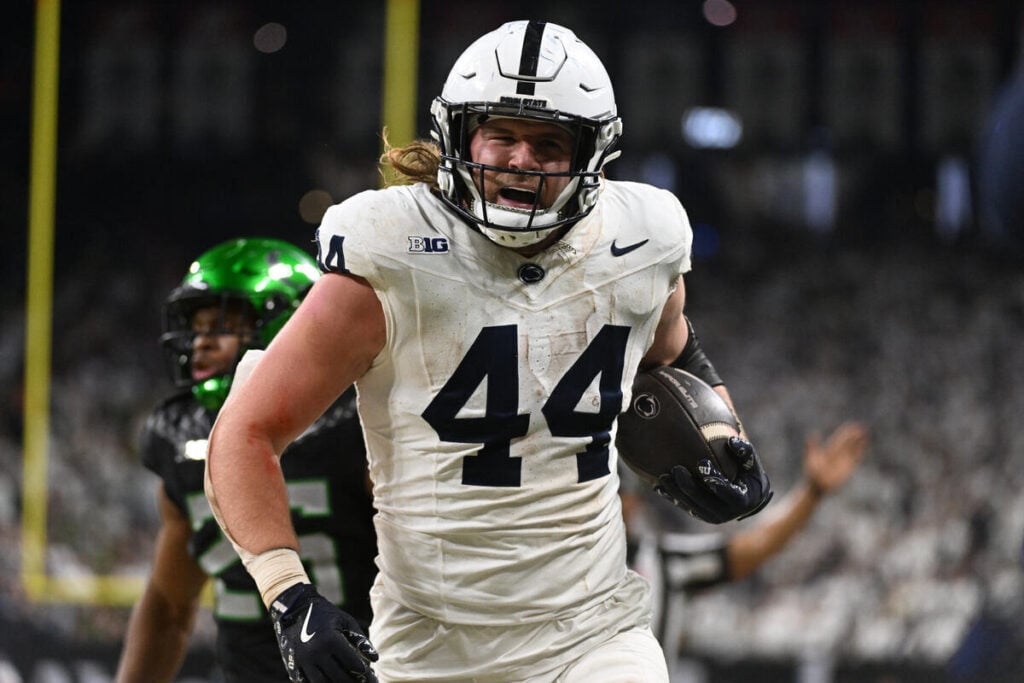
Penn State TE Tyler Warren – Photo by: USA Today
2. Michigan TE Colston Loveland – Junior – 6-5, 248 – DNP
Loveland is definitely not a bad consolation prize to whichever team takes him after Tyler Warren. In his own right, Loveland is a first-round caliber talent. While lacking the kind of high-end production of his draft class contemporary, he had a nice season for the Wolverines, recording 56 receptions for 582 receiving yards and five touchdowns in 10 games. Despite missing three games due to a shoulder injury and not having the same level of quarterback play he did with J.J. McCarthy, Loveland still found ways to be a factor.
One of the first bullet points on his scouting report should start with his separation ability, which allows him to often be a reliable target for his quarterback. Loveland releases well and creates leverage against man coverage, pairing that with sure hands. Although he has more of a leaner frame, he will fight in the run game as an in-line blocker. Don’t expect Loveland to win a boxing match with his strength to hold blocks or break free from contact, but his ability to get open holds plenty of value for teams needing another offensive weapon. There is enough to like about his game to give him a late first-round grade.
3. LSU TE Mason Taylor – Junior – 6-5, 246 – 4.68
While his dad, Jason Taylor carved out an NFL Hall of Fame career on defense, Mason Taylor will look to create his own legacy on the offensive side of the football. Taylor was molded to be a football player stemming from the bloodline he comes from, growing up around the game and getting to be around the locker room. Still, that should not overshadow all that he accomplished while at LSU. By the time it was all said and done, he finished his college career as the most productive tight end in Tigers’ history, finishing with 129 receptions and 1,308 receiving yards. Built very similarly to his dad, he uses his size to his advantage when catching in traffic.
Taylor did not have a “wow” game in college, and he averaged less than 10 yards a catch over his last two seasons. While there is a lack of explosion, he fits the bill as a chain-mover with steady hands and more room to grow into his frame and his game as he enters the league. While down a peg from Tyler Warren and Colston Loveland, Taylor has the potential to be a solid starter with a long career.

LSU TE Mason Taylor – Photo by: USA Today
4. Miami TE Elijah Arroyo – RS Junior – 6-5, 254 – DNP
Arroyo is a unique tight end prospect, only emerging during his fourth season with the Hurricanes. Having a projected top pick in quarterback Cam Ward helped, but Arroyo put himself in a position to succeed by getting healthy at the right time. After suffering a torn ACL in September 2022, his 2022 and 2023 seasons were nearly entirely wiped out. That put a lot of pressure on him to have a platform season, which he did by becoming one of Ward’s best weapons. Starting and playing in all 13 games last season, Arroyo had 35 receptions for 590 receiving yards and seven touchdowns.
Averaging nearly 17 yards a catch, it is clear that one of his biggest strengths is speed. His above-average athleticism translated into picking up a lot of chunk yardage. He is as good as they come getting yards after the catch at the tight end position and only had one drop across his college career. There is a bit of rawness to Arroyo’s game, but his ability to stretch the field as vertical weapon has value, enough to see him get drafted early on Day 2 of the 2025 NFL Draft.
5. Bowling Green TE Harold Fannin Jr. – Junior – 6-3, 241 – 4.71
When it comes to production, Fannin had the best year among tight ends in this class. Driving this home is the fact that Fannin set single-season tight end FBS records with 117 catches for 1,555 receiving yards, adding 10 touchdowns in the process. Playing at Bowling Green, he swept nearly all of the hardware in the Mid-American Conference (MAC). He was first team All-MAC en route to winning the MAC Most Valuable Player and Offensive Player of the Year awards last season. This recognition comes with the caveat of not playing against top competition, but he did have big games against Penn State and Texas A&M last season.
A converted high school safety, Fannin has had to develop a different set of ball skills transitioning to tight end at Bowling Green. He was moved all around the field in an offense catered around him, playing in-line, out wide, and in the slot. While using his speed to challenge opposing defenses in a variety of ways, his fit at the NFL level is a bit murkier. Fannin’s athleticism will be more exposed as his stiff movements will restrict him from having the success he did in college. He has the potential to be a contributor in an NFL offense that maximizes his strengths, but he will need to develop as a blocker and route runner.
6. Oregon TE Terrance Ferguson – Senior – 6-5, 247 – 4.63
Some prospects can be summed up as just being solid football players. Ferguson is one of them. There is not a ton about Ferguson’s game that is above average, but he can do a little bit of everything as a tight end. Playing for the Ducks, he racked up a lot of collegiate experience, playing in 53 games with 37 starts, becoming a full-time starter over his past two seasons. What allows him to get involved in the passing game is his speed and soft hands. Primarily used as a check down option, some of his best plays are simply snatching the ball on a short route and doing the rest himself.
Being able to move the chains is invaluable, and that comes naturally to Ferguson. He showcased enough versatility and range to fit in an NFL offense, but to truly take the next step he will need become a more polished route runner and blocker. There is a high floor to his game stemming from his speed, but his ceiling will be determined but how much more he improves in those areas. Currently, he has a middle Day 2 draft grade.
7. Texas TE Gunnar Helm – Senior – 6-5, 241 – 4.84
Helm was a big part of a Longhorns offense that propelled the team to finishing third in the College Football Playoff last season. Helm led the team with 60 receptions, while his 786 receiving yards were second behind wide receiver (and projected first-round pick) Matthew Golden. He bided his time behind Ja’Tavion Sanders for a couple of years, but there is no question he made the most of his opportunity. Some of his biggest strengths as a player are his toughness and sure hands, which will give him a fighting chance to stick at the NFL level.
The biggest knock on Helm as he enters the 2025 NFL Draft is his speed, having clocked the slowest 40-yard time of the tight ends listed here. While his 4.84 time did not light up stopwatches, he has great hands and above-average vision to create yards for himself. What Helm will bring to a tight end room is consistency and football aptitude. It may not make him a starter, but it will allow him to get some run.
8. Notre Dame TE Mitchell Evans – Senior – 6-5, 253 – 4.72
Evans has a background of doing it all. During his high school career, Evans played quarterback and punter while also playing some tight end. He would stick at the tight end position throughout his college career at Notre Dame, growing into a stout 6-foot-5, 253-pound frame. His size and functional athleticism allowed him to grow into a reliable target for the Fighting Irish as he led the team in receptions last season with 43.
Evans does not have an elite trait, but he does enough to round out an NFL tight end room. His ability to be a competitive blocker and being physical getting open will allow him to play in “12” personnel packages. Having played in a run-heavy offensive scheme, he has the floor of being a blocking tight end with solid ball skills. He had trouble staying on the field throughout his college career, but if he manages to remain healthy, he has the upside to bring some juice.
9. Syracuse TE Oronde Gadsden II – RS Junior – 6-4, 241 – 4.65
Having a dad who hauled in passes from Hall of Fame quarterback Dan Marino proved to be a transformative part of Gadsden’s life. The younger Gadsden truly grew up around the game, having been coached by his dad, Marino, and other former Dolphins in Pop Warner. Now, he looks every part of a player who can make an impact in the NFL himself. Recruited as a wide receiver like his dad was in the mid 1990s-early 2000s, Gadsden added size to his frame to become a 6-foot-4, 241-pound tight end during his sophomore season. He played the entirety of his college career at Syracuse, putting up some impressive numbers.
It started in 2022, when Gadsden was first team All-ACC after catching 61 passes for 969 receiving yards and six touchdowns. A right foot injury limited him to just two games in 2023, but he bounced back with another first team All-ACC season in 2024. A favorite of quarterback Kyle McCord’s, he caught 73 passes for 934 receiving yards and seven touchdowns. His best ability is making contested catches, blending that with the kind of quickness that makes it easy to see why he was a former wide receiver.

Syracuse TE Oronde Gadsden II – Photo by: USA Today
10. Clemson TE Jake Briningstool – Senior – 6-5, 241 – 4.75
Briningstool made the most out of being a two-year starter at Clemson. Briningstool was markedly consistent during that time, ending both years with third team All-ACC honors and while hauling in 50 and 49 receptions, respectively. When assessing his game as a whole, he offers more than just the ability to catch the football. He is a large target up the middle of the field, using that to his advantage with an above-average catch radius and presenting himself as a red zone option, having recorded 17 touchdowns during his time with the Tigers.
Briningstool has strong hands that allow him to react quickly to balls in the air and make him an aggressive blocker up the middle. Some refinement is needed to get stronger and more open, as he will get outmuscled by bigger defenders. Overall, he put enough quality tape out there against high-quality competition to suggest there is an NFL role for him as a hybrid tight end who can make a case for playing time.
11. Alabama TE CJ Dippre – Senior – 6-4, 256 – 4.69
Dippre split his time in college between two programs, having played two years apiece at Maryland and Alabama. Dippre did not put up big college numbers, failing to record a touchdown during the last two years of his college career for the Crimson Tide. What he lacked in the stat sheet he hopes to make up for with strength. He benched an incredible 32 reps at the 2025 NFL Combine, a number that is closer to some of the top offensive line prospects in this year’s class.
Dippre needs to improve his technique as a blocker, but his raw brute force gives him the chance to become above average in that area. Along with that, he spent all four years playing special teams, which gives him the base to stick on an NFL roster. Becoming anything more will mean taking his receiving skills to another level, though.
12. Nebraska TE Thomas Fidone II – RS Junior – 6-5, 243 – 4.70
Fidone did not have the ideal college career, being sidelined for half of it with two separate torn ACLs in his left knee that saw him miss the entire 2021 and 2022 seasons. When Fidone made it onto the field his final two seasons, he showcased an intriguing blend of size and speed. He went from being a wide receiver to tight end in high school but kept that acceleration off the line. His 34-inch arms are the longest at the tight end position in this class and give him an advantage when it comes to making tough catches.
Fidone does come with limitations, especially as he did not dazzle when on the field for the Cornhuskers. His lackluster college production suggests there is more room to develop as a blocker and into more of a special teamer in the NFL. The traits are there to vie for a role, but it will take him time to hit his stride and overcome missing so much time during his college career.
Best Of The Rest
13. UCLA TE Moliki Matavao – Senior – 6-5, 260 – 4.81
Splitting his time in college at two different schools on the West Coast, Matavao saved his best season for last. Matavao first entered the college ranks at Oregon, starting in eight games across two seasons before transferring to UCLA. He was the Bruins’ leading receiver with 41 receptions for 506 receiving yards and two touchdowns last season. Matavao has prototypical size for the tight end position, using every bit of it to ward of defenders attempting to bring him down. His pass catching ability and promising blocking skills will give him a fighting chance at snaps as a rookie.
14. Georgia TE Benjamin Yurosek – RS Senior – 6-4, 245 – 4.64
Yurosek spent the first four seasons of his college career at Stanford before transferring to Georgia last season. Yurosek put up some impressive numbers during his days as a Cardinal, with his best season coming in 2021 when he had 43 receptions for 658 receiving yards and three touchdowns. An alarming trend is that each year after his numbers have dipped, as he had just 15 receptions for 185 receiving yards and no touchdowns with the Bulldogs. Yurosek spent most of last season being utilized as a blocker, and it is that attribute that will give him staying power in the league. His track record of production is intriguing compared to other tight ends in this range.
15. Georgia Tech TE Jackson Hawes – Sixth-Year Senior – 6-4, 253 – 4.82
Hawes spent the first five years of his college career at Yale, where he earned a degree in economics. Hawes transferred to Georgia Tech for his final season, and that is really where he put himself on the NFL map. When assessing his game, blocking is his bread and butter. That is more because of his route running deficiencies than his blocking prowess. Hawes failed to record more than 200 receiving yards in any of his six college seasons, topping out at 16 receptions for 195 receiving yards. His poor production, age (25 years old this December) and speed limit his ceiling, but his Ivy League background and size profile suggest he can fight for a roster spot.
16. Iowa TE Luke Lachey – Redshirt Senior – 6-5, 250 – 4.85
Lachey was born and raised in the Midwest, having grown up in Ohio and spending his entire college career at Iowa. Lachey has that Midwestern toughness, but his dad being an All-Pro NFL offensive lineman in the late 1980s-early 1990s helps, too. He has a strong work ethic and that is evident in his work to be impact the run game. While he was drawn to enrolling at Iowa after seeing what their tight ends have gone on to do in the NFL, he did not have big-time college production there. Still, Lachey has enough of a skillset as a consistent pass-catcher and physical blocker to latch onto an NFL roster.
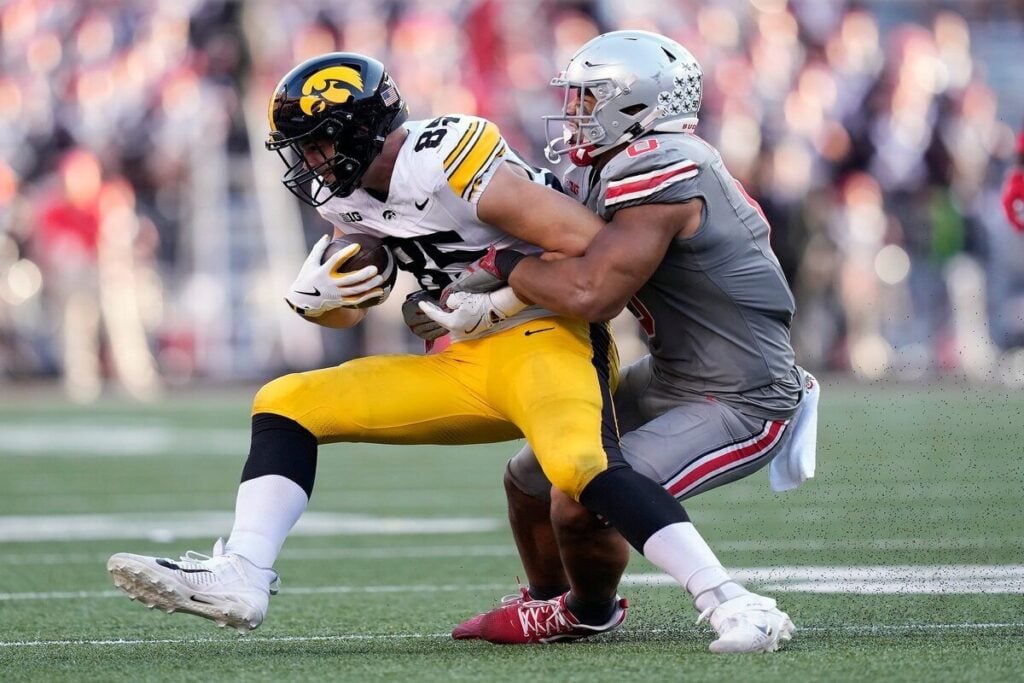
Iowa TE Luke Lachey and Ohio State ILB Cody Simon – Photo by: USA Today
Bucs Best Bets – By Scott Reynolds
Rounds 1-3: Bowling Green TE Harold Fannin Jr.
After catching 44 passes for 623 yards (14.2 avg.) and six touchdowns as a sophomore at Bowling Green, Fannin was made the focal point of the Falcons’ passing attack and had a monster junior campaign in 2024. He led all tight ends in college football with 117 receptions for 1,555 yards (13.3 avg.) and 10 touchdowns. While Fannin dominated the MAC competition, he also had huge games against both Penn State and Texas A&M early in the year. Fannin posted 11 catches for 137 yards (12.5 avg.) and one touchdown against a tough Nittany Lions defense. He followed that up with eight receptions for 145 yards (18.1 avg.) and a TD versus a stout Aggies defense.
The 6-foot-3, 241-pound Fannin received a formal interview with the Bucs at the NFL Scouting Combine, and his receiving prowess could be coveted by the team in the middle rounds. Due to his production, Fannin could be drafted in the third round. If he was more athletic, agile and a tick faster (ran a 4.71 in Indy) he could have been a second-round selection. With more pressing needs on defense it’s unlikely the Bucs would spend a Day 2 pick on another tight end, but if they do it certainly could be Fannin. He had a good showing at the Senior Bowl and ended his college career with a bang against Arkansas State in the bowl game with 17 catches for 213 yards (12.5 avg.) and one touchdown.
Rounds 4-7: Clemson TE Jake Briningstool
The Bucs have spent four Day 3 picks on tight ends in the last four years with Cade Otton and Ko Kieft in 2022, Payne Durham in 2023 and Devin Culp last year. Will Tampa Bay continue that trend this year? If so, Briningstool may be that guy. He received an informal interview with the Bucs at the NFL Scouting Combine and finished as Clemson’s all-time leading receiver at the tight end position with 127 catches for 1,380 (10.9 avg.) and 17 touchdowns.
Voted as a team captain in 2024, Briningstool only missed one game over the past three seasons and proved to be very durable. He developed as a blocker over that span and is more of a complete tight end now. At 6-foot-6, 241 pounds, Briningstool could stand to gain more muscle and mass and play at 250 pounds at the next level, which would help his in-line blocking ability. There’s a lot to like about Briningstool’s game and he could be an option for the Bucs late on Day 3.
Adam Slivon has covered the Bucs for four seasons with PewterReport.com as a Bucs Beat Writer, Social Media Manager, and Podcaster. Adam started as an intern during his time at the University of Tampa, where he graduated with a degree in Sport Management in May 2023.
In addition to his regular written content, he appears every Thursday on the Pewter Report Podcast, has a weekly YouTube Top 10 Takeaways video series, and leads the managing of the site's social media platforms.
As a Wisconsin native, he spent his childhood growing up on a farm and enjoys Culver's, kringle, and a quality game of cornhole. You can find him most often on X @AdamLivsOn.

